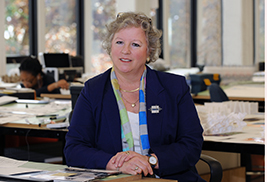Featured Article
Preventing Falls: Symposium Examines How to Keep Older Adults Healthy
Margaret P. Calkins, Ph.D., an architectural researcher, is particularly attuned to the needs of older adults whose eyesight or balance may be poor or who may live with dementia.
read moreKent State Chemistry Professor’s Longtime Collaborator Wins 2014 Nobel Prize for Chemistry
Posted Nov. 3, 2014 | Jim MaxwellIlluminating Single Molecules Within Living Cells
For Robert Twieg, Ph.D., a professor in Kent State University’s Department of Chemistry and Biochemistry, the recent news of his longtime collaborator William E. Moerner winning the 2014 Nobel Prize for Chemistry was actually no surprise at all. In fact, he believes that “he’s deserved it for a while.”
On Oct. 8, Moerner, a professor at Stanford University, was one of three researchers to win the prize for “the development of super-resolved fluorescence microscopy.” These researchers developed new techniques that give microscopes much sharper vision than was originally thought possible, and allow scientists to see living cells with unprecedented detail, at the nanoscale, to better understand diseases such as Alzheimer’s, Parkinson’s and Huntington’s.
Previously, a calculation published in 1873 known as the “Abbe Diffraction Limit” was thought to define the limit of how tiny a detail could be revealed by conventional optical microscopes. Until about 15 years ago, it was believed to be theoretically impossible to break this barrier. Now, scientists can observe individual molecules moving around and interacting with components of living cells in real time.
It’s About Collaboration
In Twieg’s eyes, in addition to fundamental scientific discoveries that are the basis of the prize, a big part of Moerner’s success is his ability to form outstanding collaborations.
“He won the Nobel prize because he’s a preeminently smart, hardworking, creative individual and he collaborated with people who can do things related to his goals,” Twieg says. “He wanted to demonstrate that super-resolution imaging is a valuable technique, so he worked with chemists who make dyes, biologists who have sophisticated know-how with biological issues and methods, and specialists in other kinds of microscopy.”
Twieg describes Moerner’s work as piecing together different parts of the puzzle and says “he’s been very successful in doing that. My work with him is just one subset of much collaboration with several other people and groups. He somehow has the skills to manage all of this.
“He’s somebody who, in his original study, said ‘I wonder if you can see a single molecule?’” Twieg says. “He figured out how to do that, then, later on said, ‘Well, what can we do with this?’ This motivated a subsequent important demonstration that single fluorescent proteins could be turned on and off. With this additional critical element, he started promoting it further and now it’s a field that’s really burgeoned and it’s growing like crazy.”
Moerner and Twieg have been collaborators since the early 1990s (when they both worked at IBM Research), and as recently as just a few weeks ago, with their students, co-authored an article in the Journal of the American Chemical Society on three-dimensional super-resolution microscopy. They also are co-authors on dozens of other publications and several patents.
Twieg’s primary role in the collaboration has been his development and understanding of fluorescent dyes for imaging that can be used to decorate living cells and can be turned on and off on-demand. Fluorescent dyes serve as the flashlight in that process and allow the researchers to precisely locate the positions of individual molecules and then superimpose multiple images thus providing an extremely high resolution of cells and their components.
Starting in 1991, their collaborations have evolved from the areas of electro-optics and photorefraction to single molecule microscopy and now super-resolution microscopy. One of the dyes that Twieg developed has been used for many years through that evolution and is currently being exploited for potential use in the organic photovoltaics field in collaboration with Kenneth Singer, Ph.D., a professor in the Physics Department of Case Western Reserve University.
“This is just another example where a good material has worked well for a lot of applications,” Twieg says.
Twieg believes that the success in what Moerner did required outstanding management.
“You start out 25 years ago with his basic discovery of seeing a single molecule, and then to turn it into something useful doesn’t happen by accident, and it’s not one person,” Twieg says. “None of those things happened spontaneously.
“A lesson learned is that if we want to make serious advances on a topic like organic photovoltaics right here at Kent State, and really accomplish something, we’re going to have to put together conceptually something very similar to Moerner’s collaboration where you have all the expertise,” Twieg adds. “It’s like building a car. You have the engine, the transmission, and if you don’t put in the steering wheel, it’s not worth a damn thing. You get nowhere. You’ve got to have all the parts and all of them operating. You have to be smart, you have to have the right staff at any given moment and you’ve got to hope that there is some destination over the horizon that you wanted to get to in the first place.
“Having a truly novel idea or goal to pursue makes the process all the more worthwhile and exciting,” Twieg says.
For more information about Kent State's Department of Chemistry and Biochemistry, visit http://www2.kent.edu/chemistry/index.cfm.
